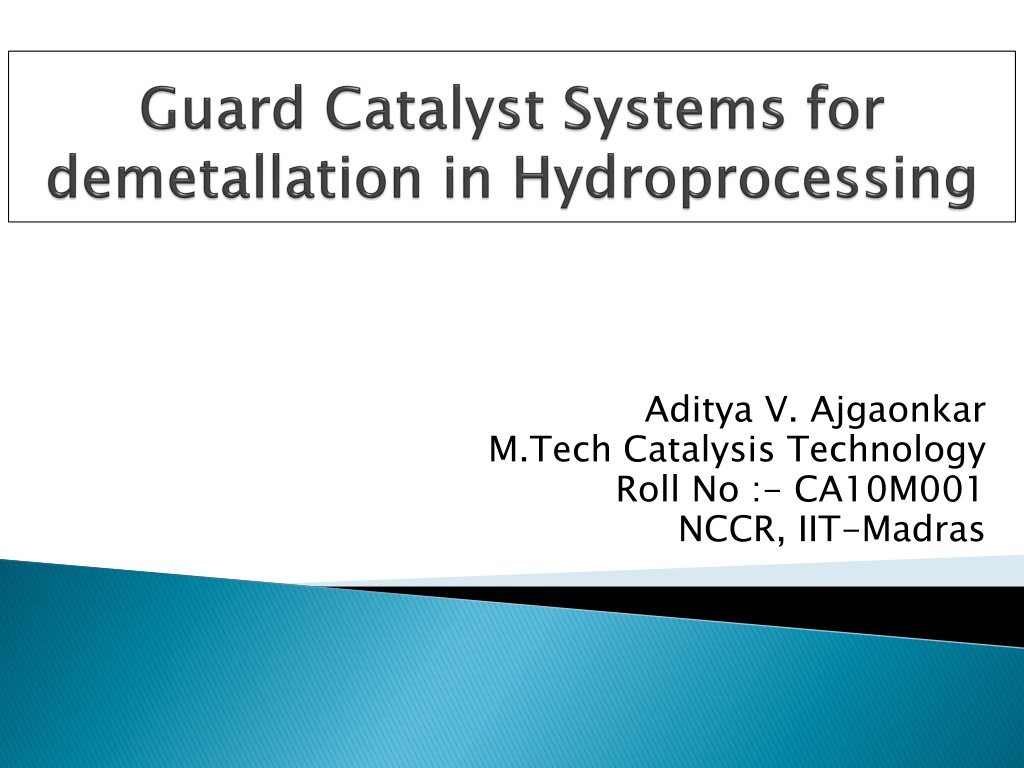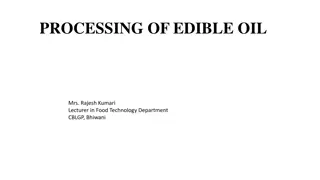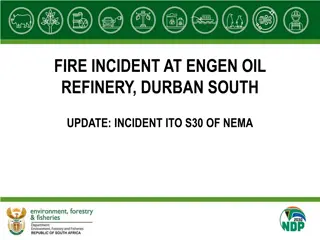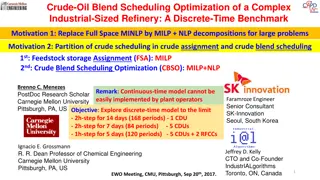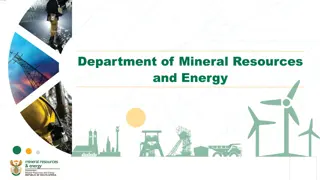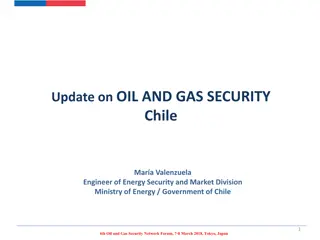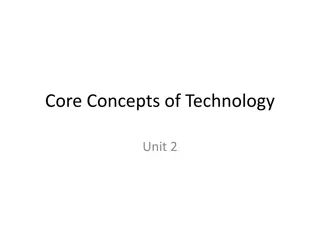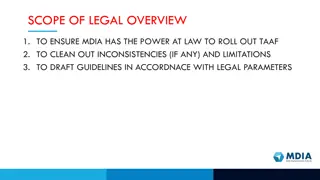Understanding Refinery Hydrotreating Technology
Refinery hydrotreating, an essential process in the petroleum industry, involves thermal treatment of feedstock with hydrogen to improve product quality, meet specifications, and develop new products. This process, including hydrodesulphurization and hydrogenation reactions, aims to enhance performance, reduce corrosion, and produce cleaner transportation fuels and petrochemicals.
Download Presentation

Please find below an Image/Link to download the presentation.
The content on the website is provided AS IS for your information and personal use only. It may not be sold, licensed, or shared on other websites without obtaining consent from the author. Download presentation by click this link. If you encounter any issues during the download, it is possible that the publisher has removed the file from their server.
E N D
Presentation Transcript
Aditya V. Ajgaonkar M.Tech Catalysis Technology Roll No :- CA10M001 NCCR, IIT-Madras
Introduction Midstream Operations : Refining and processing Upstream Operations : Oil & Gas exploration, production, transportation Downstream Operations : Petroleum product distribution and retail sale
Refinery Flow Diagram Catalytic Processes Reforming Hydrotreating Hydrocracking Alkylation Isomerization Catalytic Processes Reforming Hydrotreating Hydrocracking Alkylation Isomerization Thermal Thermal Chemical Conversion Chemical Conversion Physical Separation Physical Separation
Placement of Hydrotreating Units Hydroprocessing is a refining technology in which a feedstock is thermally treated with hydrogen under pressure. HDT HDT Hydrotreating (HDT) is carried out for feed treatment and for product quality improvement. HDT HDT It is therefore an important and most practiced process in industry. HDT HDT Based on the amount of catalyst sold hydrotreating catalysts constitute third largest business. HDT
Why Hydroprocessing ? The purposes of refinery hydroprocessing are : To improve the existing petroleum products To enable petroleum products meet the specifications To develop new products or new uses of the existing products To convert inferior or low grade materials into valuable products To transform near solid residua into liquid fuels
Hydrotreating T, P, Conversion Temperature 300- 450 deg. C Pressure 0.7-15 MPa Low Conversions of feedstock
Hydrotreating Reactions Hydrodesulphurization (HDS) Hydrodemetallation (HDM) H2 (H2S) M- porphyrin MxSy + H- porphyrin Hydrodeoxygenation (HDO) Hydrodenitrogenation (HDN) Hydrogenation of olefins Hydrogenation of aromatics Hydrodechlorination (HDCl)
Why Hydrotreating ? The purposes of refinery hydrotreating are : Reduction, or elimination, of corrosion during refining, handling, or use of the various products To produce clean products for transportation fuels and petrochemicals Increasing performance (stability) of gasoline Decreasing smoke formation in kerosene Reduction of heteroatom content in fuel oil to a level that improves burning characteristics and is environmentally acceptable
Metal compounds in Petroleum Both Ni and V in petroleum exist as soluble organometallic complexes that fall in two categories : 1) Metal porphyrins 2) Non-porphyrin metal complexes These compounds are distributed over a wide boiling range (350 650 deg C).
Metal compounds in Petroleum Metal Compounds Porphyrins Non-porphyrins Asphaltenes Significant amount is associated with asphaltenes. Biological , Non-biological origin. At least one double bond on methine bridge or pyrrole ring is hydrogenated. Diameter is of the order of 0.8-1 nm which may get expanded due to substitution. Hydroporphyrins Aryl porphyrins
Metal compounds in Petroleum Porphyrins account for only half of the V and Ni present in the petroleum crude. The remaining part of the metals was supposed to comprise less-defined forms which may involve some bonding with heteroatoms in resins and asphaltenes. Asphaltenes contain porphyrins and non porphyrins depending upon the origin of the crude oil.
Metal content Metal content varies depending upon the type of crude. Generally varies between few ppm to 1000 ppm. Vanadium content is more than Nickel except few exceptions.
Metal content The trace metals Ni and V are generally orders of magnitude higher than other metals in petroleum. Part of the metallic constituents of crude oils exist as inorganic water- soluble salts, mainly as chlorides and sulphates of Na, K, Mg, Ca. These may due to contact with brine salts. They are removed by desalting. Arsenic is also present but it has received little attention till now.
Why Hydrodemetallation ? Metals affect many upgrading processes. V and Ni deposit as sulfides at the pore mouth and block the pores in hydrotreating catalysts (HDS, HDN catalysts) Ni deposits on the catalyst, acts as dehydrogenation catalyst, enhances production of undesirable products such as hydrogen and coke. As the catalyst ages Ni migrates to the interior. Ni initially deposits on the exterior
Why Hydrodemetallation ? V like Ni also catalyzes dehydrogenation reactions to form hydrogen & coke, however activity is to of Ni. V is more notorious because it causes destruction of zeolite structure. Dissolution of zeolite crystals Vanadic acid is not consumed but acts as catalyst getting regenerated after every cycle.
Why Hydrodemetallation ? In high-temperature power generators, such as oil fired gas turbines, the presence of metallic constituents may lead to ash deposits on the turbine rotors, thus reducing clearances and disturbing their balance. The ash resulting from the combustion of fuels vanadium reacts with refractory furnace linings to lower their fusion points and so cause their deterioration.
Hydrodemetallation Mechanism H H2 2 H H2 2 H H2 2 Ring Ring H H+ +/H /H2 2 Fragmentation Fragmentation Ring opening & acid attack Ring opening & acid attack + Metal Sulfides Jansen et al. Appl. Catal. 179 (1999 1999) 229
Hydroprocessing Catalysts Catalyst Components Important Parameters I ) Appropriate Composition (Selectivity / Stability) Acidity (Cracking) Basicity (Selectivity/stability) RE-zeolite scavenger Support Modified Zeolites (by exchanging) Mixed Oxide II ) Meso / Macropores Diffusion of large molecules Stability Macroporous Amorphous filler matrix Porosity III ) Catalytic Active Components Metal Loading High dispersion of active sites IV) Catalytic Activities Primary / secondary reactions Hydrotreating Hydrogenation / Dehydrogenation Cracking Isomerization (alkylation) Cyclization (Polymerization) Aromatization Active Metals Ni-Mo / Ni-W / Co-Mo Pt/Pd/Ru/Rh Leyva et al., Ind. Eng. Chem. Res. 2007 2007, 46, 7449
Guard Catalyst Guard Catalysts : High HDM
Hydrodemetallation Catalysts Anchetya et al., Catal. Today 2005 2005, 109, 3-15
Rana et al. : Studied the effect of alumina preparation on HDM Parameters Studied : Catalyst : Alumina (support) prepared by urea (u), ammonium carbonate (acs) and ammonium hydroxide (am) as hydrolyzer. Temperature : 380 deg. C Pressure : 5.4 MPa Co- Mo (Active metals)
Maity et al. : Studied the effect of active metals on HDM Parameters Studied : Catalyst : Alumina (support) Temperature : 380 deg. C Pressure : 5.4 MPa Co- Mo, Ni-Mo, Co-W, Ni-W(Active metals) Catalys ts MoO3 WO3 CoO NiO P2O5 A 15 4 B 15 4 C 20 4 D 20 4 E 10 3 0.8 Co-Mo > Co-W Ni-Mo > Ni-W Co-Mo > Ni-Mo
Problem Statement The project aims to carry out demetallation (HDM) reactions by synthesizing guard catalyst systems. Proposed Catalysts : Metal Sites (Active Component): Co, Ni, Mo Support : Mesoporous Alumina, Silica
